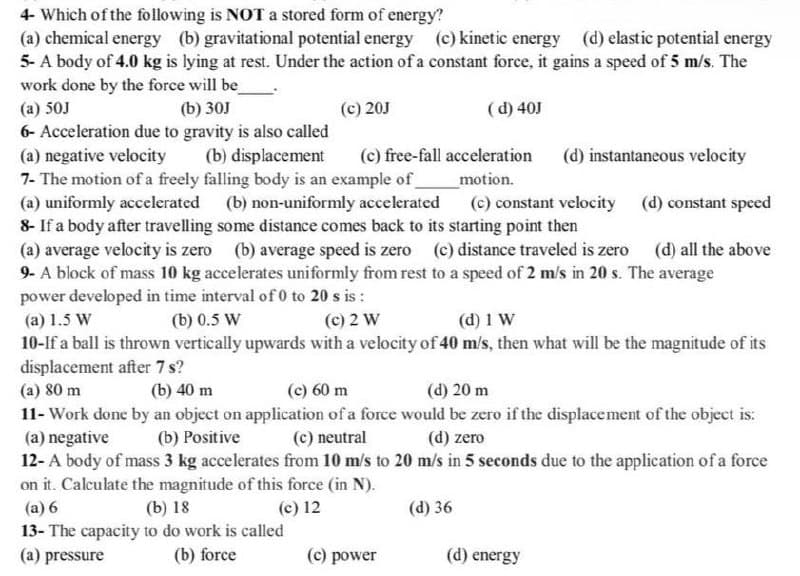4- Which of the following is NOT a stored form of energy? (a) chemical energy (b) gravitational potential energy (c) kinetic energy (d) elastic potential energy 5- A body of 4.0 kg is lying at rest. Under the action of a constant force, it gains a speed of 5 m/s. The work done by the force will be
4- Which of the following is NOT a stored form of energy? (a) chemical energy (b) gravitational potential energy (c) kinetic energy (d) elastic potential energy 5- A body of 4.0 kg is lying at rest. Under the action of a constant force, it gains a speed of 5 m/s. The work done by the force will be
An Introduction to Physical Science
14th Edition
ISBN:9781305079137
Author:James Shipman, Jerry D. Wilson, Charles A. Higgins, Omar Torres
Publisher:James Shipman, Jerry D. Wilson, Charles A. Higgins, Omar Torres
Chapter4: Work And Energy
Section: Chapter Questions
Problem BM
Related questions
Topic Video
Question
i need the answer quickly

Transcribed Image Text:4- Which of the following is NOT a stored form of energy?
(a) chemical energy (b) gravitational potential energy (c) kinetic energy (d) elastic potential energy
5- A body of 4.0 kg is lying at rest. Under the action of a constant force, it gains a speed of 5 m/s. The
work done by the force will be_
(a) 50J
(b) 30J
(c) 20J
(d) 40J
6- Acceleration due to gravity is also called
(a) negative velocity
(b) displacement
(c) free-fall acceleration (d) instantaneous velocity
_motion.
(d) constant speed
7- The motion of a freely falling body is an example of
(a) uniformly accelerated (b) non-uniformly accelerated (c) constant velocity
8- If a body after travelling some distance comes back to its starting point then
(a) average velocity is zero (b) average speed is zero (c) distance traveled is zero
9- A block of mass 10 kg accelerates uniformly from rest to a speed of 2 m/s in 20 s. The average
power developed in time interval of 0 to 20 s is:
(d) all the above
(a) 1.5 W
(b) 0.5 W
(c) 2 W
(d) 1 W
10-If a ball is thrown vertically upwards with a velocity of 40 m/s, then what will be the magnitude of its
displacement after 7 s?
(a) 80 m
(b) 40 m
(c) 60 m
(d) 20 m
11- Work done by an object on application of a force would be zero if the displacement of the object is:
(a) negative (b) Positive
(c) neutral
(d) zero
12- A body of mass 3 kg accelerates from 10 m/s to 20 m/s in 5 seconds due to the application of a force
on it. Calculate the magnitude of this force (in N).
(a) 6
(b) 18
(c) 12
(d) 36
13- The capacity to do work is called
(a) pressure
(b) force
(c) power
(d) energy
Expert Solution
This question has been solved!
Explore an expertly crafted, step-by-step solution for a thorough understanding of key concepts.
Step by step
Solved in 2 steps

Knowledge Booster
Learn more about
Need a deep-dive on the concept behind this application? Look no further. Learn more about this topic, physics and related others by exploring similar questions and additional content below.Recommended textbooks for you

An Introduction to Physical Science
Physics
ISBN:
9781305079137
Author:
James Shipman, Jerry D. Wilson, Charles A. Higgins, Omar Torres
Publisher:
Cengage Learning

Principles of Physics: A Calculus-Based Text
Physics
ISBN:
9781133104261
Author:
Raymond A. Serway, John W. Jewett
Publisher:
Cengage Learning

College Physics
Physics
ISBN:
9781285737027
Author:
Raymond A. Serway, Chris Vuille
Publisher:
Cengage Learning

An Introduction to Physical Science
Physics
ISBN:
9781305079137
Author:
James Shipman, Jerry D. Wilson, Charles A. Higgins, Omar Torres
Publisher:
Cengage Learning

Principles of Physics: A Calculus-Based Text
Physics
ISBN:
9781133104261
Author:
Raymond A. Serway, John W. Jewett
Publisher:
Cengage Learning

College Physics
Physics
ISBN:
9781285737027
Author:
Raymond A. Serway, Chris Vuille
Publisher:
Cengage Learning

College Physics
Physics
ISBN:
9781938168000
Author:
Paul Peter Urone, Roger Hinrichs
Publisher:
OpenStax College


Modern Physics
Physics
ISBN:
9781111794378
Author:
Raymond A. Serway, Clement J. Moses, Curt A. Moyer
Publisher:
Cengage Learning